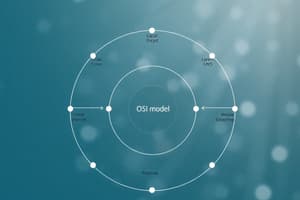Podcast
Questions and Answers
What does the OSI Model help us to understand?
What does the OSI Model help us to understand?
Functions that occur in networking
Which of the following layers is responsible for the physical transmission of digital data?
Which of the following layers is responsible for the physical transmission of digital data?
- Physical Layer (correct)
- Network Layer
- Transport Layer
- Application Layer
The Data Link layer is the simplest layer in the OSI model.
The Data Link layer is the simplest layer in the OSI model.
False (B)
What is the primary role of the Transport Layer?
What is the primary role of the Transport Layer?
Which protocol is the most common example of a Transport Layer network protocol?
Which protocol is the most common example of a Transport Layer network protocol?
What does the Session Layer manage?
What does the Session Layer manage?
The ____ layer handles syntax processing of message data.
The ____ layer handles syntax processing of message data.
What does the Application Layer provide?
What does the Application Layer provide?
Which layer is responsible for error recovery and flow control?
Which layer is responsible for error recovery and flow control?
Match the following OSI layers with their primary functions:
Match the following OSI layers with their primary functions:
Flashcards
OSI Model Layer 1
OSI Model Layer 1
The Physical Layer; responsible for the transmission of data bits over the network medium, such as Ethernet cables.
OSI Model Layer 2
OSI Model Layer 2
The Data Link Layer; responsible for checking transmission errors and controlling physical addressing like MAC addresses.
OSI Model Layer 3
OSI Model Layer 3
The Network Layer; responsible for routing data packets and logical addressing like IP addresses.
OSI Model Layer 4
OSI Model Layer 4
Signup and view all the flashcards
OSI Model Layer 5
OSI Model Layer 5
Signup and view all the flashcards
OSI Model Layer 6
OSI Model Layer 6
Signup and view all the flashcards
OSI Model Layer 7
OSI Model Layer 7
Signup and view all the flashcards
Physical Addressing
Physical Addressing
Signup and view all the flashcards
Logical Addressing
Logical Addressing
Signup and view all the flashcards
ARP (Address Resolution Protocol)
ARP (Address Resolution Protocol)
Signup and view all the flashcards
HTTP
HTTP
Signup and view all the flashcards
TCP (Transmission Control Protocol)
TCP (Transmission Control Protocol)
Signup and view all the flashcards
Network Request(Example)
Network Request(Example)
Signup and view all the flashcards
7 Layers (OSI)
7 Layers (OSI)
Signup and view all the flashcards
Network Architecture
Network Architecture
Signup and view all the flashcards
Study Notes
OSI Model - Introduction
- The OSI Model helps understand network functions, web browser operation, internet protocol, and MAC addresses.
- Learning the OSI Model aids troubleshooting and communication with technical personnel.
- The model is a framework to implement protocols in layers with control passed between layers.
OSI Model Layers
- The model conceptually divides network architecture into 7 layers:
- Application (Layer 7) - Handles user applications, like a web browser
- Presentation (Layer 6) - Handles data format conversions (e.g., image formats)
- Session (Layer 5) - Manages connections and how they initiate and close.
- Transport (Layer 4) - Handles communication between applications, using protocols like TCP or UDP.
- Network (Layer 3) - Uses logical addresses (e.g., IP addresses) and deals with routing of data.
- Data Link (Layer 2) - Manages physical addressing schemes, like MAC addresses in ethernet networks
- Physical (Layer 1) - Responsible for ultimate bit transmission over the network, using electrical voltages, radio frequencies, or infrared/light signals.
OSI Model - Network Architecture
- The OSI model, shown in figure 1.17, defines a networking framework for protocol implementation.
- The layers have a logical progression, with lower layers handling signals and routing, and higher layers handling network requests and responses.
- Layer 1,Physical Layer, is accountable for transmitting digital data bits between devices.
- Layer 2, Data Link Layer, checks for transmission errors and packages bits into frames.
- Layer 3, Network Layer, handles routing via logical addresses (like IP addresses) and translating to physical addresses.
- Layer 4, Transport Layer, delivers data across connections, using protocols like TCP.
- Layer 5, Session Layer, is responsible for how network connections are initiated or terminated.
- Layer 6, Presentation Layer, is the simplest layer in the OSI model, handles data format conversions and encryption/decryption.
- Layer 7, Application Layer, provides network services to end-user applications.
OSI Model - Example (Web Browser)
- A web browser interacts with a web server to retrieve a webpage.
- The browser interacts with the application layer (HTTP) to request a webpage.
- The request travels through Presentation, Session, Transport, Network, Data Link, and Physical layers to reach the server.
- Similar communication occurs for responses received and displayed by the browser.
Studying That Suits You
Use AI to generate personalized quizzes and flashcards to suit your learning preferences.




